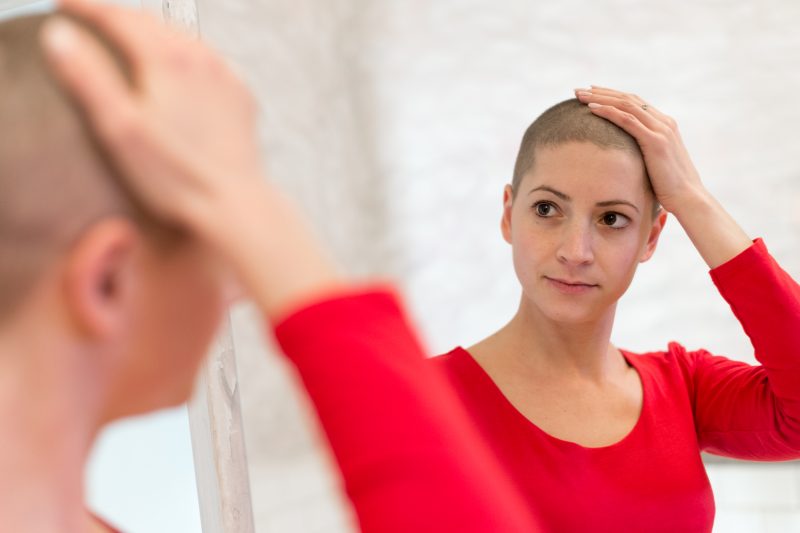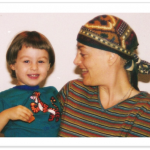PUBLISHED: 1st June 2017

by Sue Friedman
I was happy to read the XRAY report on research about scalp cooling to prevent hair loss during chemotherapy. Chemo-related hair loss is more than merely an inconvenience during cancer treatment. My own experience as a young breast cancer survivor on chemotherapy convinced me of this.

I was 33 when I was diagnosed with early-stage breast cancer. At the time, my primary concern was choosing a treatment that gave me the best chance of surviving to raise my 2-year-old son. I had additional concerns about treatment side effects, such as nausea, fatigue and low blood counts, all of which affected my ability to tolerate treatment. And as a young mother, it was important for me to have enough energy to parent my young son and to try to give him as normal a childhood as possible.
To avoid clumps of hair in the sink, a thinning hairline, and the accompanying sickly look, I took matters into my own hands and visited the hospital salon for a pre-emptive head shave before starting treatment. It was simultaneously terrifying—symbolic of my upcoming chemotherapy—and freeing—restoring a semblance of control over one aspect of my treatment. Sporting my new look, I bought some camouflage t-shirts and prepared myself to battle breast cancer.
Despite my efforts to project a positive image, venturing hairless out in public left me vulnerable, and people often felt free to offer commentary, telling me why they thought I got cancer, offer wild advice about some new “miracle cure” that didn’t make hair fall out, or detailing friends’ or relatives’ cancer treatment horror stories. Too many everyday trips to the park or the playground ended up being yet another stigmatizing reminder of my diagnosis and treatment. Had it been available back then, I might have jumped on the opportunity to avoid chemotherapy-induced hair loss.

Many patients express deep fear of chemotherapy. I can relate. Cancer can be all-consuming, and any reprieve from side effects is welcome. Some patients choose to forego chemotherapy to avoid side effects; so research on methods to minimize the side effects of treatment can be lifesaving.
XRAY reviewed research on a scalp-cooling devices to prevent hair loss due to chemotherapy. This is exactly the type of product I might have invested in during my own treatment. I had limited resources, and although I avidly read every media article about breast cancer that I could get my hands on, I didn’t always have access to the journal article or the full story. The XRAY report has balanced information, including the limitations of the research study, information that most of the media reports glossed over. For example, this research didn’t include women who received the same type of chemotherapy that I had. A report like this can help women in treatment to weigh their options. This is particularly important for those who, like me, experienced medical debt from treatment, and for whom the additional cost of this intervention would not be covered by insurance.
This is the goal of XRAY: to help people make use of reports on cancer in the media so that they can make informed and shared decisions with their health care team.
5 Comments
November 4, 2017
Hi Sue, I used Peniguin cold caps this year and I want to try to get insurance companies to cover it or at least help out in the costs. It helped me tremendously knowing that I was working hard to save my hair so I wouldn't stand out as another cancer patient. I have appealed twice to Anatheim Blue Cross and have been denied. They say I have no more appealls left. They wouldnt even offer me the $1,500 that they allow for a wig. I spent $4,000 in five months to save my hair. Can FORCE help me help me change this?
Louise Barnett
Reply
May 31, 2023
Very brave woman I say. I mean cancer is not a joke and undertaking chemo therapy will make you really look sick and it will definitely make your hair loss. But as for you, you faced it well with courage and I really do admire you for that. Thanks for sharing your experience to us.
Samara
Reply
October 18, 2023
thnkss
caroline natalia
Reply
November 25, 2019
How brave of you to share your experience about visiting the hospital's salon for a pre-emptive head shave. One of my aunts is starting chemo therapy soon, and she is afraid of losing her hair. We will speak to her about your brave encounter so she will overcome the fear and be prepared for her therapy.
Eli Richardson
Reply
June 21, 2022
Thanks for sharing
Archna
Reply